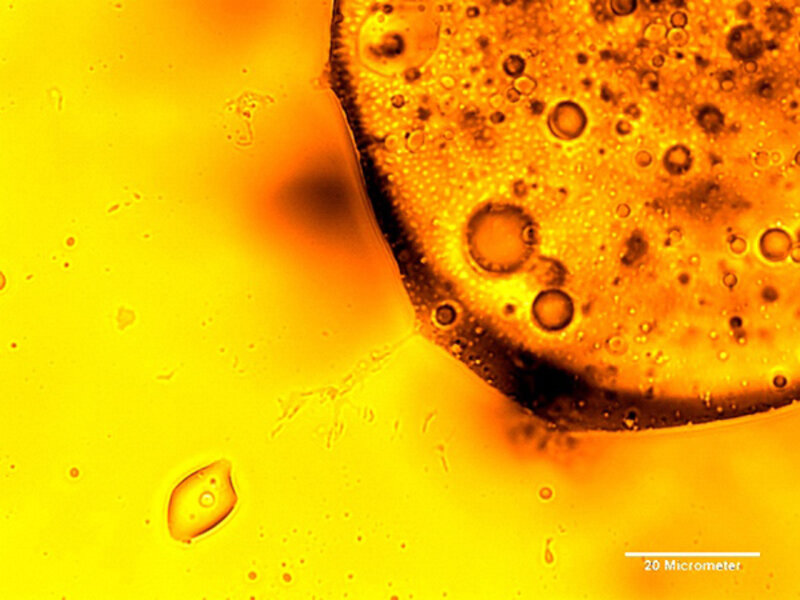99.999 percent of microbe species remain undiscovered, say researchers.
Loading...
Earth could contain 1 trillion microbial species, but humans only know about 0.001 percent of them, two biologists from Indiana University suggest in a paper published Monday in Proceedings of the National Academy of Sciences.
"We've done a pretty good job of cataloguing macrobes. Maybe every few years you'll hear about a new worm at the bottom of the ocean, but the rate we are exploring new [plants and animals] is slowing down," Jay Lennon, a microbial biology researcher at Indiana University Bloomington (IU) and co-author of the new study, tells The Christian Science Monitor in a phone interview Sunday.
"But it's only in the last 20 to 30 years that people have figured out how to identify microbes; we are still in an area of discovery. Before this study, it was hard to know where we were. These are the most abundant life on Earth, so from a scientific perspective, we've missed a huge group," he says.
From bacteria to fungi, microbes are everywhere. For example, Dr. Lennon suggests there are 10,000 different kinds of bacteria on one square centimeter of a human arm at any given time. While people may be unenthusiastic about this fact – or even grossed out – humans rely on microbes for functions we rely on, such as nutrient cycling, digestion, clean water, and more. And microscopic organisms play crucial roles in everyday functions that humans haven't even yet attributed to them.
"An estimated 40 percent of the world's economy is derived from biological resources, but the vast majority of biodiversity still remains to be documented and described," Simon Malcomber, lead program director for the National Science Foundation's Dimensions of Biodiversity, which funded the IU study, tells the Monitor. "By losing biodiversity, humans are losing links from within the web of life that provide important ecosystem services, and are losing the opportunity to discover future beneficial bio-inspired discoveries and innovations."
To create the largest microorganism database of its kind, the scientists from IU combined microbial, plant, and animal statistics from government, academic and individual studies, bringing together a database of more than 5.6 million species (both microscopic and nonmicroscopic) from 35,000 different locations around the world.
Lennon and his colleague, IU postdoctoral fellow Kenneth Locey, then applied mathematical scaling laws to predict the number of species in an individual landscape.
"Until now, we haven't known whether aspects of biodiversity scale with something as simple as the abundance of organisms," Dr. Locey says in the university's press release. "As it turns out, the relationships are not only simple but powerful, resulting in the estimate of upwards of 1 trillion species."
What's most striking about their study is "the sheer diversity of microorganisms that surround us, and how little we know about them," says Malcomber. "This study emphasizes how we need to increase our efforts to document and describe this microbial diversity and then start to understand the myriad roles these organisms likely play in global ecosystems."
Ninety-five percent of life on Earth is smaller than the eye can see, Laura Hug, a University of Waterloo (Canada) professor who studies microbiology, told the Christian Science Monitor last month. Dr. Hug recently published a paper in the journal Nature Microbiology that identifies 1,000 previously undocumented microbes. Like Lennon and Locey, Hug's study was made possible because of a scientific breakthrough in the field in microorganism identification.
"Previously, scientists looking to identify new organisms by their genomes would isolate and cultivate the cells in a lab," the Monitor's Eva Botkin-Kowacki reported. "But not all organisms can survive and grow in that environment. Many of these microorganisms depend on other organisms. But now, using genome-based approaches developed in the past two decades, scientists are able to dig into the DNA of microbes in their environment."
And while Lennon and Locey's groundbreaking study may have acknowledged the existence of 1 trillion species, actually identifying all of these species is "an almost unimaginably huge challenge." For comparison, the Earth Microbiome Project, an international, interdisciplinary effort to catalog microbial communities around the world, has identified fewer than 10 million species to date.
But ignorance should not lead to indifference, the authors conclude in their study. Instead, "the profound magnitude of our prediction for Earth's microbial diversity stresses the need for continued investigation."








